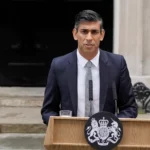Ministry of Defence says Russia relying on ‘poorly trained force’ as Kremlin seeks to consolidate gains
Russia’s defence minister said 82,000 conscripts had already been sent to Ukraine, reflecting what the west called a desperate effort to halt Kyiv’s counter offensive with poorly trained troops.
Sergei Shoigu told president, Vladimir Putin, that a further 218,000 were being trained in barracks, and that the controversial “partial mobilisation” had concluded, although it was not possible to verify the figures cited.
The meeting between the two was broadcast on Russian state television, with Shoigu telling Putin: “The task set by you of (mobilising) 300,000 people has been completed. No further measures are planned.”
The emergency draft began in September, after Ukraine won a string of victories in the north-west near Kharkiv, prompting some Russians to protest and others to flee the country. Dozens of conscripts have been killed after being thrown into the frontline to protect more experienced troops in the rear.
Britain’s Ministry of Defence said on Friday that Russia was seeking to consolidate its existing gains after eight months of hard fighting by relying on “severely undermanned, poorly trained force” that were “only capable of defensive operations”.
But, despite the critical analysis, there are signs that the growing use of conscripts by Russia has slowed Ukraine’s advance in both the east and the south of the country, as the autumn turns towards winter.
Serhiy Haidai, the Ukrainian governor of the east Luhansk region, said “the advance of Ukrainian troops forward is not going as fast as we would like it to” in a television interview, because Russia has managed to recover its reserves and dig in.
Thousands of conscripts had been deployed in places such as Bakhmut, where Haidai said they were being killed or wounded quickly after being thrown into battle against dug-in Ukrainians. “The average ‘shelf life’ of mobilised personnel is about two weeks,” the governor added.
Ukraine’s general staff said on Friday that up to 1,000 Russian conscripts had been sent across the Dnipro River to fortify Kherson, demonstrating that the Kremlin is unwilling to give up the city without some sort of a fight. The troops would be billeted in homes belonging to residents who had fled the war.
A week ago it appeared that Russia feared losing the city and had relocated commanding officers across to the east bank of the river – and begun evacuating civilians, an exercise that Ukraine said amounted to forced deportations.
Ukraine retook a string of villages near Kherson in early October, but earlier this week defence minister, Oleksii Reznikov, warned that the autumn rains had “slowed us down a bit” and progress had become gradual.
Locals say the terrain between the Ukrainian held city of Mykolaiv and Kherson is particularly difficult because the flat ground is cut by large irrigation canals, some of which have been drained, but in either case are easily fortified.
Western military experts have long predicted a slow down in the tempo of fighting in November as heavy rains clog the ground and make it increasingly difficult for armoured vehicles to operate off road. The battle may not pick up again until the depths of winter, when the ground freezes.
Kherson’s Russian appointed governor said earlier this week that the tomb and remains of Prince Grigory Potemkin, once the chief minister and lover of 18th century ruler Catherine the Great, had been taken from a cathedral in Kherson and moved deeper into occupied territory.
“We have moved the remains of his serene highness Prince Potemkin from St Catherine’s church and the monument itself to the left bank,” east of the Dnipro River, Volodymyr Saldo said, according to Russian state news agency reports.
Another Russian official said the evacuation of civilians from Kherson had concluded. “The work to organise residents leaving to the left bank of the Dnipro to safe regions of Russia is completed,” said Sergei Aksyonov, the Moscow-appointed head of Crimea, late on Thursday, after a visit to the area.
Ukraine’s air force said it has shot down more than 300 Iranian Shahed-136 ‘kamikaze’ drones so far, although that figure is only a fraction of the 2,400 that the country believes Russia has acquired from Tehran.
Russia has used the hard to detect drones to help target Ukraine’s power stations and energy grid during October. Power blackouts, aimed at destabilising the energy supply, are now routine in many of the country’s major cities.
Vitali Klitschko, the mayor of Kyiv, said that the city’s power grid was operating in “emergency mode,” with electricity supplies down by as much as a half compared with prewar levels. Four hour blackouts have been announced in and around the capital.
Oleg Syniehubov, the governor of the Kharkiv region, announced on Telegram that daily one-hour power outages would begin on Monday, including the regional capital, which is Ukraine’s second-largest city.
Ukraine’s presidential office said that at least four civilians have been killed and 10 others wounded by the latest Russian attacks, with heavy shelling damaging dozens of residential buildings and power lines near the southern city of Nikopol.


